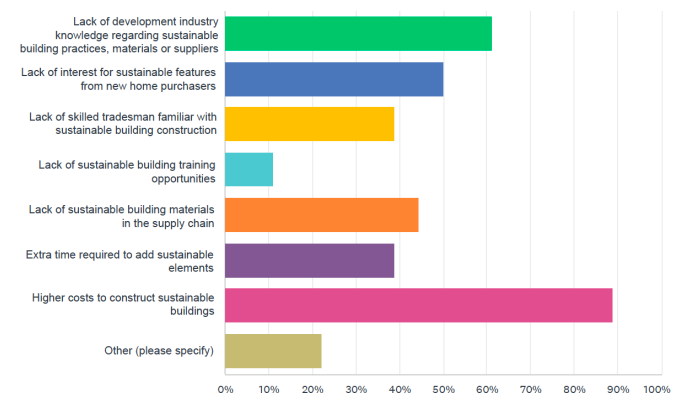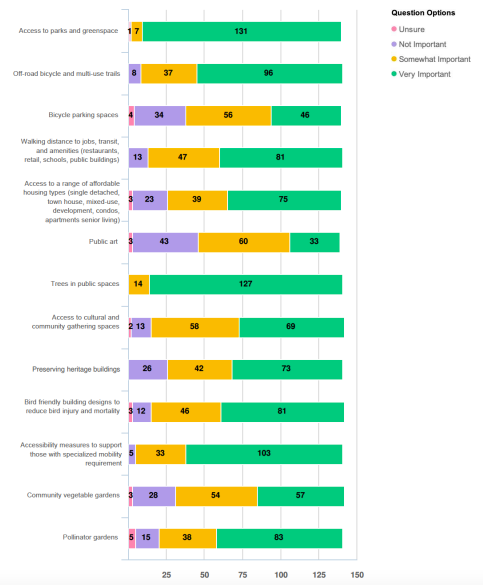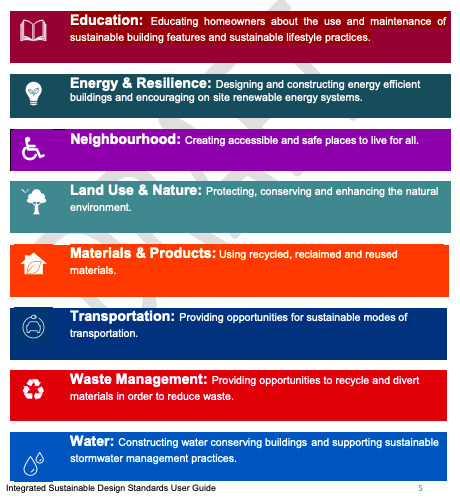The City of Pickering’s Integrated Sustainable Design Standards (ISDS)
Marisa Carpino, Clean50 honouree, outlines the process behind Pickering’s development of Integrated Sustainable Design Standards, and how challenges throughout the process were identified and overcome.
Pickering is expected to lead the province of Ontario in growth over the next 15 to 20 years. The most obvious challenge lies in how the City can work with developers to ensure that this growth is sustainable and that new development can continue to be reviewed through a lens that includes modern green best practices and technology.
The City recognized that creating updated Integrated Sustainable Design Standards (ISDS) would be one of the strongest and most effective solutions to help us achieve our goal.
A growing community requires thoughtful planning around opportunities for housing supply and diversity, dedicated community facilities and spaces, key service and infrastructure investments, and economic development, with jobs close to home. Additionally, a key priority for Pickering is to build complete, vibrant, and sustainable communities.
“By connecting with a variety of stakeholders, the City created a set of standards that balanced sustainability with the viability of development.”
Marisa Carpino, MA
Given that the building sector is responsible for 40% of total carbon emissions in our region, we knew that these standards would require a collaborative and extensive effort, with engagement from the development community and members of the public.
Three main challenges that we encountered through the process of developing the standards were:
1. Financial: The City faced budget constraints during COVID-19 and new projects like this were unable to proceed without external grant support. As such, the staff team applied for funding, and were successful in securing a grant from The Atmospheric Fund, and additional financial support from the Region of Durham, to help offset some of the cost.
Our funding partners were able to provide technical advice and practical guidance from their experience working on green standards across Ontario. Staff found that aside from financial support, strategic partners who share the same vision can create opportunities for knowledge sharing, networking and future collaborations.
2. Engagement: It was staff’s observation that across the GTHA, sustainable development standards had often been met with skepticism and resistance from stakeholders in the past. Some members of the development community have expressed concern with municipalities’ legal authority to implement standards. Another reason for this resistance is that the standards can be viewed as a hurdle to development, or costly to implement.

Sustainability is a complex but fundamental principle for all aspects of development that requires thorough review and participation from many stakeholder groups. As such, staff created a comprehensive engagement strategy for all phases of the project, and found this to be key in ensuring that Members of Council were provided with balanced feedback and perspectives to support the standards.
Another key lesson learned from the ISDS initiative was to ensure we identified all of the stakeholders with whom we needed to consult, and that enough time and resources were provided to execute a thoughtful and meaningful engagement strategy.
To help facilitate dialogue with the development community, a Building Advisory Panel was formed specifically for this initiative. The Panel was comprised of representatives from the development community (including associations) to represent diverse built forms. Over the course of the project, the City engaged with this panel through a series of surveys, workshops, and one-on-one meetings, to collect feedback, and identify opportunities and barriers to build more sustainably.
The City also reached out to the general public including schools, community groups and organizations, places of worship, and businesses. The City used various tools, both online and inperson, to solicit feedback, including: media releases, Let’s Talk Pickering platform, municipal website page (pickering.ca/standards), social media campaigns, posters, banners and rack cards in municipal facilities and at events, digital sign promotions, among other tools.

Targeted emails were sent directly to known community leaders and groups, and to development community representatives. By using broad and diverse outreach techniques, we were able to connect with hundreds of people on this important topic. By connecting with a variety of stakeholders, the City created a set of standards that balanced sustainability with the viability of development.
Based on comments from our Building Advisory Panel, the City adjusted our project timelines and extended the deadline for participation. This flexibility and commitment allowed us to have more meaningful discussion with stakeholders.
3. Creating Progressive Standards: The City needed to create a set of standards that:
- reflect the needs of a growing residential community;
- respond to climate change; and
- consider the practical limitations of construction within the development community.
Pickering’s original Sustainable Development Guidelines were released in 2007. As a first step, research was completed to identify the gaps in the guidelines that needed to be filled to represent the best practices of today and what the preferred structure of the ISDS looked like.
Then staff followed a methodical approach to develop a new set of standards that aligned with other GTHA municipalities, and that reflected the priorities of all stakeholders. ISDS Performance Measures and Criteria are categorized into seven areas: Education, Energy & Resilience, Neighbourhood, Land Use & Nature, Transportation, Waste Management, and Water.
A final key finding from the ISDS project was the need to balance the unique challenges, and often competing interests, of stakeholder groups. Key challenges include:
- increased demand for housing, mass transit, and other infrastructure;
- affordability, accessibility, and age-friendliness of housing;
- resiliency of built form to the impacts of climate change; and
- housing supply shortages, rising costs of materials and labour, and lack of skilled trades.
City staff also met with the GTHA municipalities to understand their experience in developing their own standards. Staff found that there were some internal and external barriers resulting from a lack of clarity around terms and implementation process. As such, City staff created a plan to support users in understanding and adopting the ISDS. A Training Guide and video for internal staff use, and an additional User Guide for the development community, are being created to assist with this new approach and to clarify requirements.
The City of Pickering is committed to supporting others and participating in opportunities for shared learning and collaboration. Accordingly, we are happy to be involved in this Clean50 forum. To help accelerate the process for other municipalities, a Lesson-Learned report is being released later this year, which will document the City’s approach to the ISDS.

Next Steps. Endorsed by Pickering Council, the ISDS standards will come into effect January 1, 2023. The team is in the process of establishing enforcement mechanisms and a framework that will help ensure the development community is adhering to their identified performance measures. Draft development agreements, and/or final plans, will contain specific conditions for meeting the ISDS measures, committed to by the applicant on their ISDS Checklist.
Unique to Pickering, staff may attend the site during construction to verify installation of sustainability features. Letters of Credit may be required as a mechanism to secure the completion of the works. A Post Construction and Verification Checklist will be completed by the applicant prior to releasing Letters of Credit. These mechanisms can be used as tools for other municipalities to implement in their own process.
Overall, the ISDS will result in an industry shift to improve sustainability in the City of Pickering, and ensure development is reviewed and constructed through a lens that includes modern green best practices and technology.













